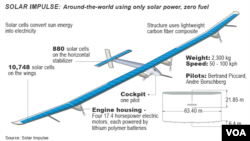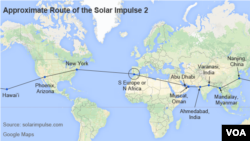A solar-powered Swiss airplane has landed in Oman after completing the first leg of its around-the-world journey without any fuel.
The plane touched down Monday in Muscat, about 10 hours after it took off from Abu Dhabi.
The carbon fiber single-seater Solar Impulse 2 aircraft has a 72-meter wingspan, which is longer than the wingspan of a Boeing 747, and weighs about as much as a car. The 17,000 solar cells built into the wings harness the sun's energy, allowing it to fly through the night.
"Solar Impulse wants to mobilize public enthusiasm in favor of technologies that will allow decreased dependence on fossil fuels, and induce positive emotions about renewable energies,'' a statement on the official mission website said. The site maps out the plane's location and broadcasts audio from the cockpit in real time.
The Si2 took 12 years to build and is the brainchild of two Swiss scientists, Bertrand Piccard and Andre Borschberg.
Borschberg, who was in the pilot's seat Monday, is the CEO of Solar Impulse. He is a trained fighter pilot and a professional airplane and helicopter pilot. He and Piccard will trade off piloting duties during stopovers.
Piccard is a psychiatrist, an explorer and the aeronaut who made the first-ever non-stop round-the-world balloon flight.
The two say they are not out to revolutionize the aviation industry, but are instead aiming to demonstrate that actual alternative energy sources and new technologies can achieve what some consider impossible.
"Miracles can be achieved with renewables such as solar power,'' Swiss pilot Bertrand Piccard, who also made the first non-stop circumnavigation of the globe in a balloon in 1999, told Reuters in January.
"We want to show we can fly day and night in an aircraft without a drop of fuel,'' he said.
Some legs of the Si2 trip will require the pilots to be in the tiny cockpit for five to six days and nights in a row. So it is a good thing that the multi-purpose pilot's seat also functions as both a recliner and a toilet.
The aircraft's route includes stops in Oman, India, Mandalay, Myanmar and China. After crossing the Pacific Ocean via Hawaii, the plane will also make up to three stops in the U.S., touching down in Phoenix, Arizona and New York City, and possibly another location depending on weather conditions.
The final legs after crossing the Atlantic include a stopover in southern Europe or North Africa before arriving back in Abu Dhabi in late July or early August.
Some material for this report came from Reuters








